
GEOL 101 Exam 2 Review
Sedimentary Rocks: Interlude B and Chapter 6
Introduction to sedimentary rocks (5, 6)
Sedimentary rock: Rock that forms by cementing together of fragments, broken off, pre-existing rock, or by the precipitation of mineral crystals out of water solutions at or near the earth surface.
Las Vegas is built on unconsolidated sediment.
Most of the Earth’s surface is covered with layers of loose sediment.
~75% of the land surface is sedimentary rock.
All sediment and sedimentary rock make up less than 10% of all rocks on this planet.
Sedimentary rocks preserve the history of how the surface environment changed through time.
Sedimentary rocks are the only rocks with fossils inside them.
Sedimentary rocks hold all of Earth’s reserves of:
Oil
Gas
Coal
Groundwater
Sand is the second most used resource behind water.
Sediments: loose fragments of rocks or minerals from the weathering process.
Transforms bedrock into detrital clasts and possibly into soil.
Clasts: Can be the broken down bits of a rock. Can be a mineral that wasn’t created but it was eroded out, broken out, or weathered out and now its loose clast.
Types of weathering
Physical weathering: Erodes rock into clasts of variable size.
Jointing: causes natural cracks in rock
Wedging: forces causing expansion of preexisting cracks in rock (root, salt, ice).
Chemical weathering: Chemical reactions of minerals in rocks to air or water.
Dissolution: causes minerals in rocks to dissolve in water (ex: calcite).
Oxidation: a reaction where elements combine with oxygen.
Differential weathering: Different layers of rock weather at different rates due to their difference in composition.
Sedimentary rock types (16)
Clastic: loose rock fragments (clasts) cemented together.
Chemical/biochemical: minerals that crystallize directly from water or from biologic activity.
Organic: carbon-rich remains of once-living organisms.
Clastic sedimentary rocks and grain characteristics (rounding, sorting, size) (17-19)
Clastic sedimentary rocks: consists of mineral grains, rock fragments, and cementing material.
Clastic sedimentary rocks are formed by:
Weathering: rock disintegration
Erosion: removal of grains
Transportation: movement of sediments by gravity, wind, water, and ice
Deposition: settling out of the transportation medium
Compaction: additional overlying material provides pressure
Lithification: transformation into solid rock
Grain size: the diameter of individual grains of sediment or lithified particles in clastic rocks.
Very coarse to very fine
gravel, sand, silt, and clay
As transport distance increases, grain size decreases.
Angularity: degree of edge or corner smoothness
Angular, subangular, subrounded, rounded
Angular edges → rock was formed close to where it was weathered.
Rounded → rock was formed farther away from spot of origin.
As transport distance increases, roundness increases.
Sorting: a measure of the uniformity of grain sizes in rock (poorly to well sorted)
As transport distance increases, sorting increases (well sorted)
Very poorly sorted, poorly sorted, moderately sorted, well sorted, very well sorted
Conglomerate rock → coarse, angular, gravel, poorly sorted
Sandstone → medium grain, subangular, sand, moderately sorted
Siltstone → medium/fine grain, subrounded, silt, well sorted
Shale → fine grained, rounded, clay and silt, very well sorted
Chemical sedimentary rocks (25,26)
Chemical sedimentary rocks: produced by inorganic precipitation of dissolved compounds (example: through oversaturation or evaporation).
Limestone
Evaporites
Biochemical sedimentary rocks: made of sediments from the shells of once-living organisms.
Depositional environments for rock outcrops found around Las Vegas (38-43)
Depositional environments: the environment where the rock was formed.
Different environments vary in energy regime, sediment transport, and depositional processes and chemical, physical, and biological characteristics.
Mt. Charleston
Limestone
Red Rock Canyon
Cross-bedding
Fossils
Tule Springs Fossil Beds
Fossils
Sedimentary structures - cross bedding (33, 34)
Bedding reflects changing conditions during deposition.
Stratification displays sedimentary rocks as layers, close to horizontal beds.
Bedding plane: the boundary between two beds.
Water flowing over loose sediments creates bedforms, which directly reflect flow velocity and grain size. They are useful indicators of environmental conditions.
Ripple marks: ridges and troughs that develop perpendicular to flow in sandy sediments.
Cross bedding: created by ripple and dune migration
Sand moves up the gentle side and piles up at the crest.
Then, it slips down the steep face.
The slip face faces are preserved as cross beds.
Graded bedding: from bottom to top, coarse materials settle and finer grains are seen on the top part of the bedding.
Mud cracks: indicate alternate wet and dry terrestrial conditions.
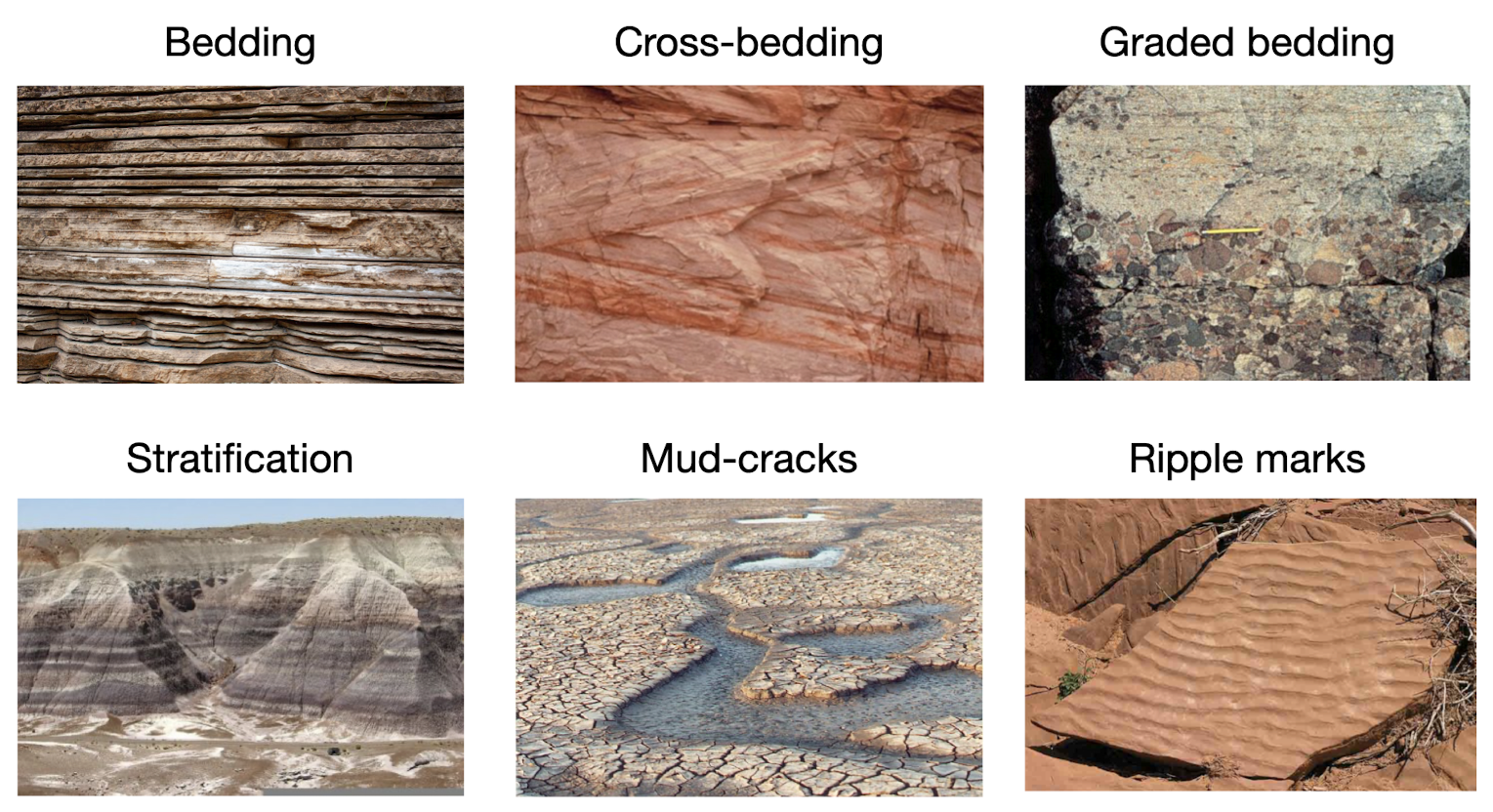
Metamorphic Rocks: Chapter 7 and Interlude C
Intro to metamorphic rocks, alteration of mineralogy and texture (5-7)
Metamorphic rocks: are those that have undergone solid-state diffusion of pre-existing rocks.
Meta means change, morphe means form
Protoliths: pre-existing rocks that are altered during metamorphism.
Metamorphism can alter any protolith (igneous, sedimentary, metamorphic).
Protoliths undergo changes in mineralogy and texture due to variations in temperature, pressure, tectonic stress, and water.
Mineralogy of metamorphic rocks
Metamorphic rocks may keep some of the same minerals of its protolith, but can form new minerals too.
Texture of metamorphic rocks
Metamorphism creates intergrown and interlocking grains.
Metamorphism often imparts a foliation upon the new rock.
Foliation is a planar fabric that cuts through the rock due to alignment of platy minerals and can lead to alternating light/dark bands.
Agents of metamorphism - Temperature and Pressure (8)
Temperature: heat causes the atoms in a mineral to vibrate, rapidly, stretching, bending, or breaking chemical bonds. Between 500-1500 F
Can cause ions to break a part.
Pressure: near the surface, minerals are more stable, under extreme pressure is the atoms can pack together, more closely in denser minerals form.
Temperature and pressure determine metamorphic grade.
Metamorphic grade - low to high grade metamorphism (9, 10)
Metamorphic grade is a measure of the intensity of temperature and pressure conditions that lead to alteration.
Different temperature and pressure conditions occur in different geologic settings.
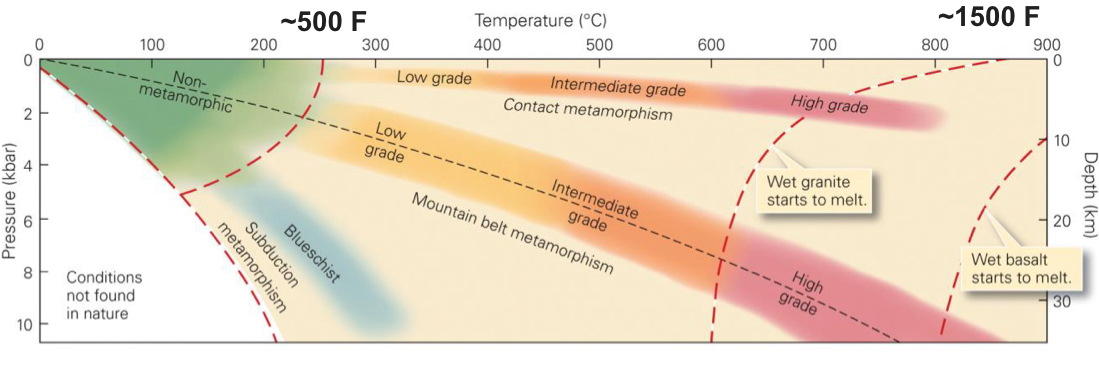
Low temperature, low pressure → low grade
High temperature, high pressure → high grade
In between temperature and pressure → intermediate grade
A sedimentary protolith (shale) changes to into different rocks with increasing metamorphic grade (increasing heat and pressure).
Shale → Slate → Schist → Gneiss
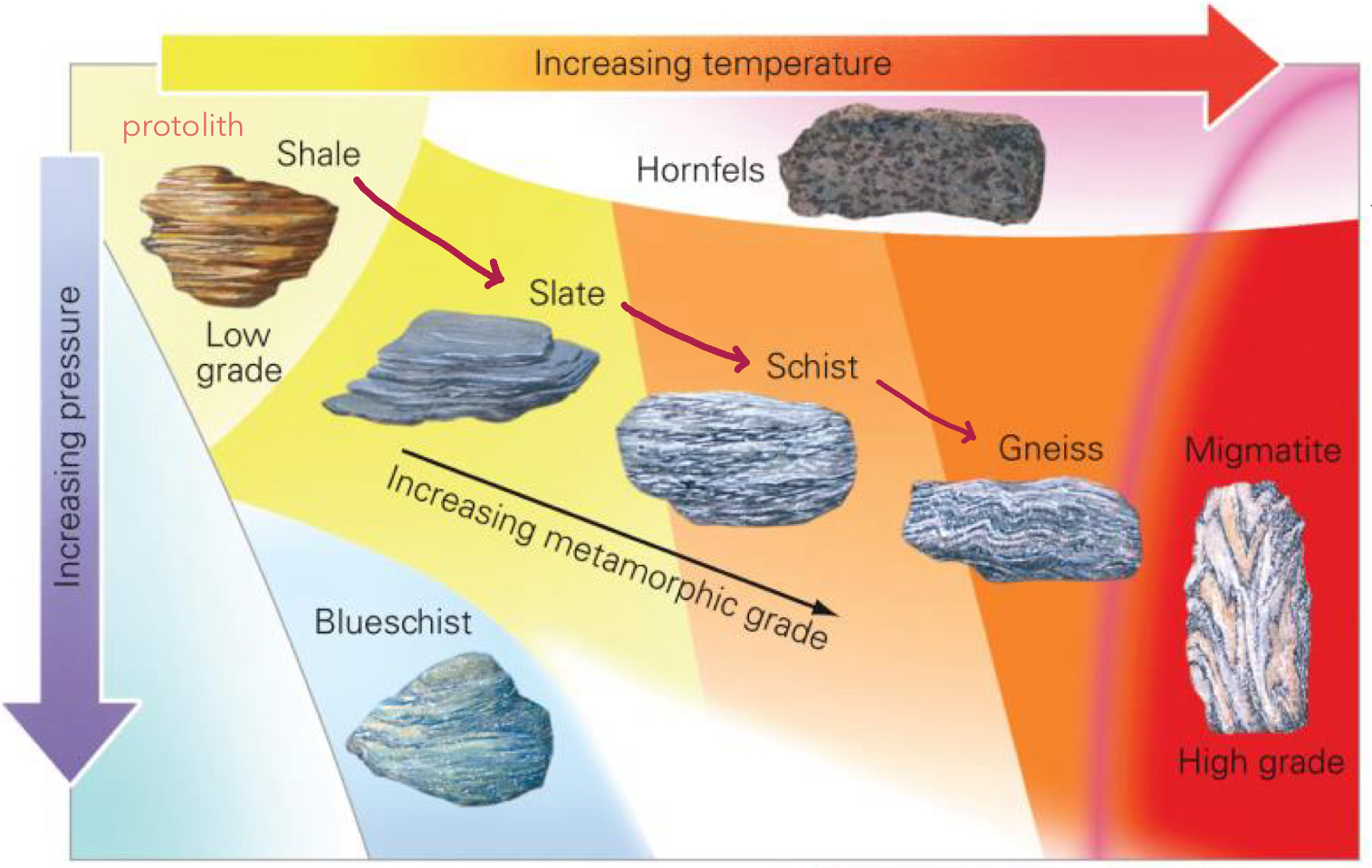

Metamorphic settings - contact vs. regional vs. subduction (11, 12)
Contact/thermal (slides 13-15)
Low pressure, high temperature
Plutonic intrusion - heat from a body of magma invading host rock
Hydrothermal waters - cold water seeps into fractured crust, water is heated by magma, hydrothermal water reacts and chemically alters basalt.
Dynamic fault zone shearing - breaking of rock
Subduction (slide 16)
Volcanic arc (low pressure, high temperature)
Accretionary prism (high pressure, low temperature)
Regional (slide 17)
Pressure and temperature fluctuate
Mountain forming event
Burial
Orogenesis - development of mountain belts
Not all agents are required to alter a rock mass, although they often co-occur.
Metamorphic processes - recrystallization and neocrystallization (20, 21)
Recrystallization: changes the texture (size and shape of crystals), but the minerals stay the same. Caused by change in temperature.
Neocrystallization: results in new (metamorphic) minerals from old (those that were in the protolith).
Protolith minerals become unstable and undergo chemical reactions that recycle elements to form a new mineral assemblage.
Texture can change and foliation can occur.
Foliation from differential stress (24, 26)
Differential stress: stress that is greater in ONE direction.
Differs from pressure because pressure is of equal magnitude in all directions.
It causes inequant mineral shapes to align in preferred orientations.
Commonly takes place from tectonic forces.
Mountain building → horizontal compression (push)
Rifting → horizontal extension (pull)
Two types of differential stress: Normal and Shear
1.) Normal stress: operates perpendicular to a surface.
Compression: push-together normal stress
Tension: pull-apart normal stress
2.) Shear stress: acts parallel to a surface.
Compression and shear combined with elevated temperature and pressure cause minerals and rocks to change shape without breaking.
Internal textures are changed as minerals rotate or dissolve and recrystallize in preferred orientations.
Differential stress results in foliation of a rock.
Rock cycle case study - Black Hills (47)
Began with sedimentary rocks.
An igneous intrusion metamorphosed the sedimentary rocks through contact metamorphism to make schist.
Sedimentary rocks were buried, underwent uplift and erosion, brought igneous and metamorphic rocks to the surface.
Another sea covered the area creating think sedimentary rock sequence. Limestone had undergone dissolution to form a vast cave system in the hills.
Another intrusion occurs, uplifts entire rock sequence, begins the uplift of the Rocky Mountains.
Sedimentary rocks erode away from high relief areas and exposes crystalline core. Sedimentary rocks ring outer parts of the hills.
Sediment transferred eastward through streams, sediments traveled to flatter lying areas, created sediments seen in Badlands.
Class Questions
The main difference between pressure and differential stress is that differential stress applies pressure, but that pressure is unequal in all directions - meaning there is more pressure coming in from one of these sides.
Foliation is the term that best describes the changes that occur to a metamorphic rock when a planar fabric cuts through rock?
Fossils and Geologic Time: Interlude E and Chapter 10
Intro to fossils (2)
Paleontology: the study of fossils.
Fossils are remnants or traces of ancient living organisms.
Created by burial with rock material and preserved lithification.
Fossils are in sedimentary rocks, some in air-fall ash deposits.
Fossilization modes - types of preservation and how preservation takes place (4, 6, 8)
Mummification
Freezing
Aridity
Burial
Stages
Footprints left in mud
Dinosaur collapses and dies
Flesh rots, bones remain
Water level increases, sediments bury footprints and bones
Think sequence of sediments collects over bones, bones fossilize
Erosion exposes bed containing the bones and footprints
Amber
Molds/casts of invertebrates
Trace fossils of footprints, burrows, or dung
Recrystallization of body fossils
Permineralization of plants
Carbonization of soft organisms
Highest preservation potential with:
Rapid burial and low energy
Low oxygen (anoxic)
Hard parts
No diagenesis
No metamorphism
What gets fossilized:
Hard parts or traces - mostly
Exoskeletons, shells, teeth, bones, bark, tracks, impressions
Soft parts - but rarely
Internal organs, skin tissue, feathers
What fossils can tell us (11)
Individuals
Behavior
Morphology and mechanistics
Paleopathology
Community dynamics
Who’s top predator
Paleoecology
Paleoenvironments
Evolution (14)
Evolution: the gradual change of physical traits of organisms through time.
Taxonomic relationships - Kingdom down to genus → more closely shared traits (16)
Taxonomy: how we classify organisms
Binomial nomenclature: every organism has a two part scientific name that identifies its closest relatives and infers its evolutional history.
Eukarya is the most inclusive.
Humans are related to worms on animal kingdom level.
Middle column of table shows how subdivisions apply to humans.
As you move down, more traits are shared.
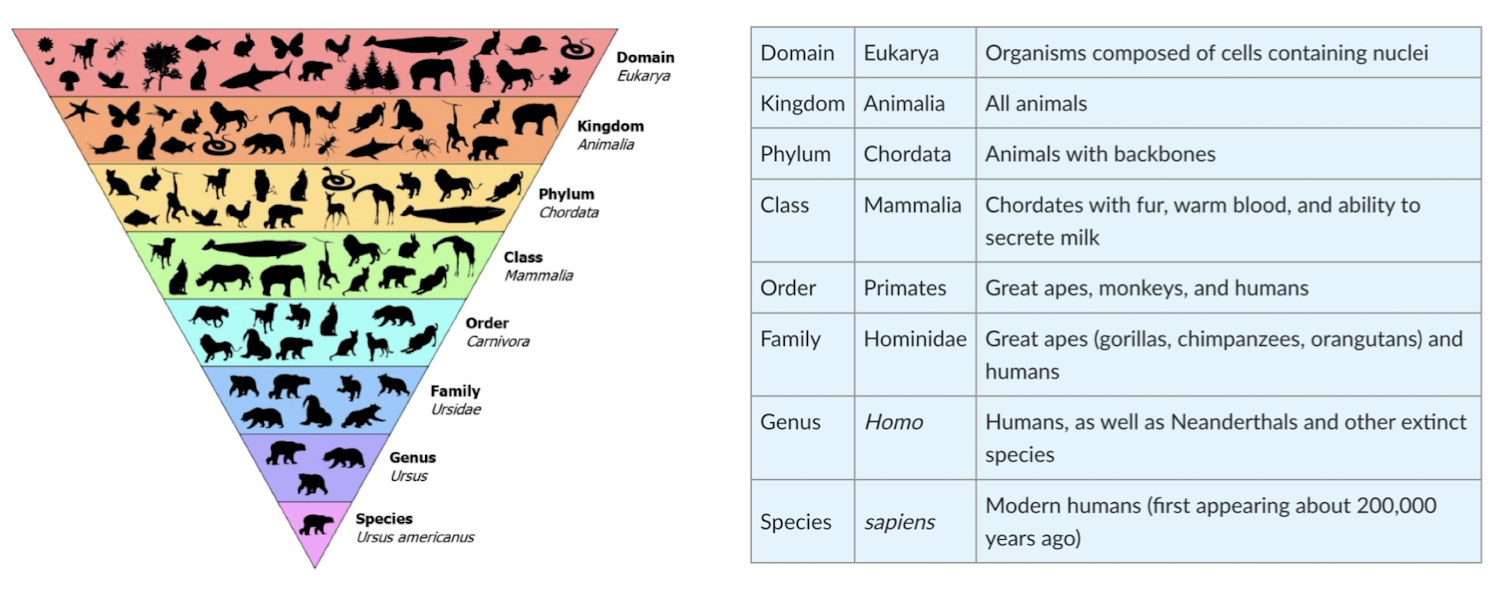
Mass extinctions - 6 mass extinctions have taken place (21)
Extinctions - when last member of a species die off.
Mass extinctions are global, abrupt decreases biodiversity.
6 mass extinctions:
Ordovian-Silurian
Late Devonian
Permian-Triassic
Triassic-Jurassic
Cretaceous-Paleogene
Anthropocene
Geologic time scale(25, 26)
Geologic time scale: Precambrian → Paleozoic → Mesozoic → Cenozoic → Anthropocene
Age of humans: Anthropocene
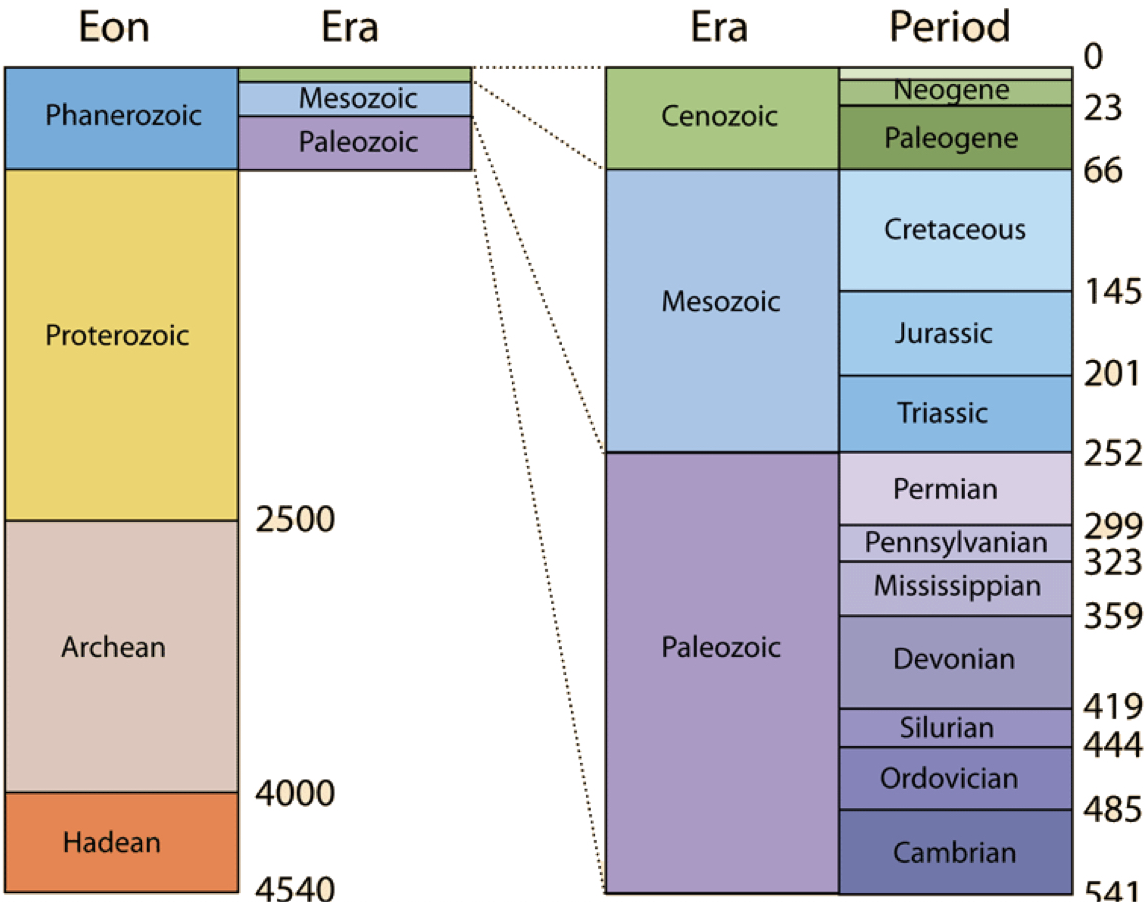
Relative dating principles #1-8 (30-37)
1 block digram will be on the exam
Uniformitarianism: processes observed today are the same as what has occurred through Earth’s history.
Original horizontality: sediments settle out of fluid by gravity and accumulate horizontally, tilted sedimentary rocks must be deformed.
Superposition: an undeformed sequence of layered rock has youngest strata on top, oldest on the bottom.
Lateral continuity: subsequent erosion dissects once-continuous layers.
Cross-cutting relations: younger features cut across older features.
Faults, dikes, erosion must be younger than the material faulted, intruded, or eroded.
Baked contacts: igneous intrusion cooks the invaded country rock.The baked rock is older.
Inclusions: occurrence of rock fragments within another rock. Inclusions are older than the enclosing material. Fragments (xenoliths) in igneous intrusion are always older. Rock had to exist first to be included in another rock.
Faunal succession: species evolve, exist for a time, and then disappear. Useful for relative dating.
Relative dating application (41)
Helps sort out sequence of events and relative ages of complex situations.
Diagram is on exam,must be able to put them in order.
1. Limestone
2. Shale
3. Sandstone
4. Shale
5. Sandstone
6. Shale
7. Sandstone
Darker gray layer → sill
Vertical gray → basalt dike
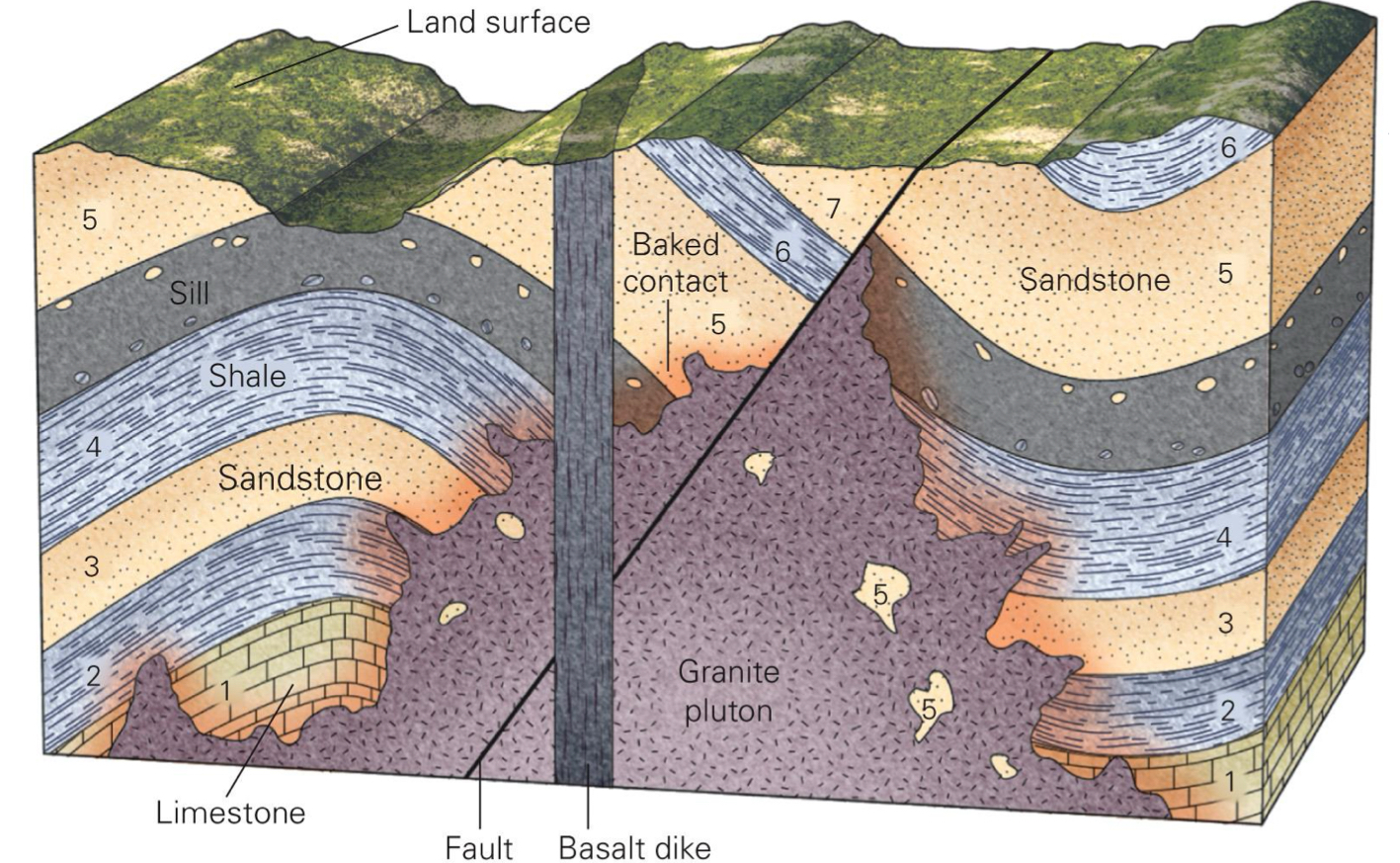
Unconformities - angular, non, dis, and rock types/relationships associated with each (46-48)
Unconformities: gaps in the rock record from either nondeposition or erosion.
Angular unconformity: underlying layers are tilted.
Nonconformity: underlying layers are igneous or metamorphic rocks, layers are not tilted.
Example: Black hills
Disconformity: underlying layers are sedimentary, layers are not tilted.
Example the Grand Canyon
Absolute dating - parent → daughter, half life, what rocks can be dated (54, 55, 57)
Parent isotopes to daughter isotopes, they decay by half-life, that half life is strict, unmoving. Its the same rate every single time it’s decay takes place.
Isotopes - elements with varying neutrons
Half life - time it takes for half of unstable nuclei to decay.
As parent disappears, daughter increases
1 half life → ½ of the original parent remains.
2 half lives → ¼ of the original parent remains.
3 half lives → 1/8 of of the original parent remains.
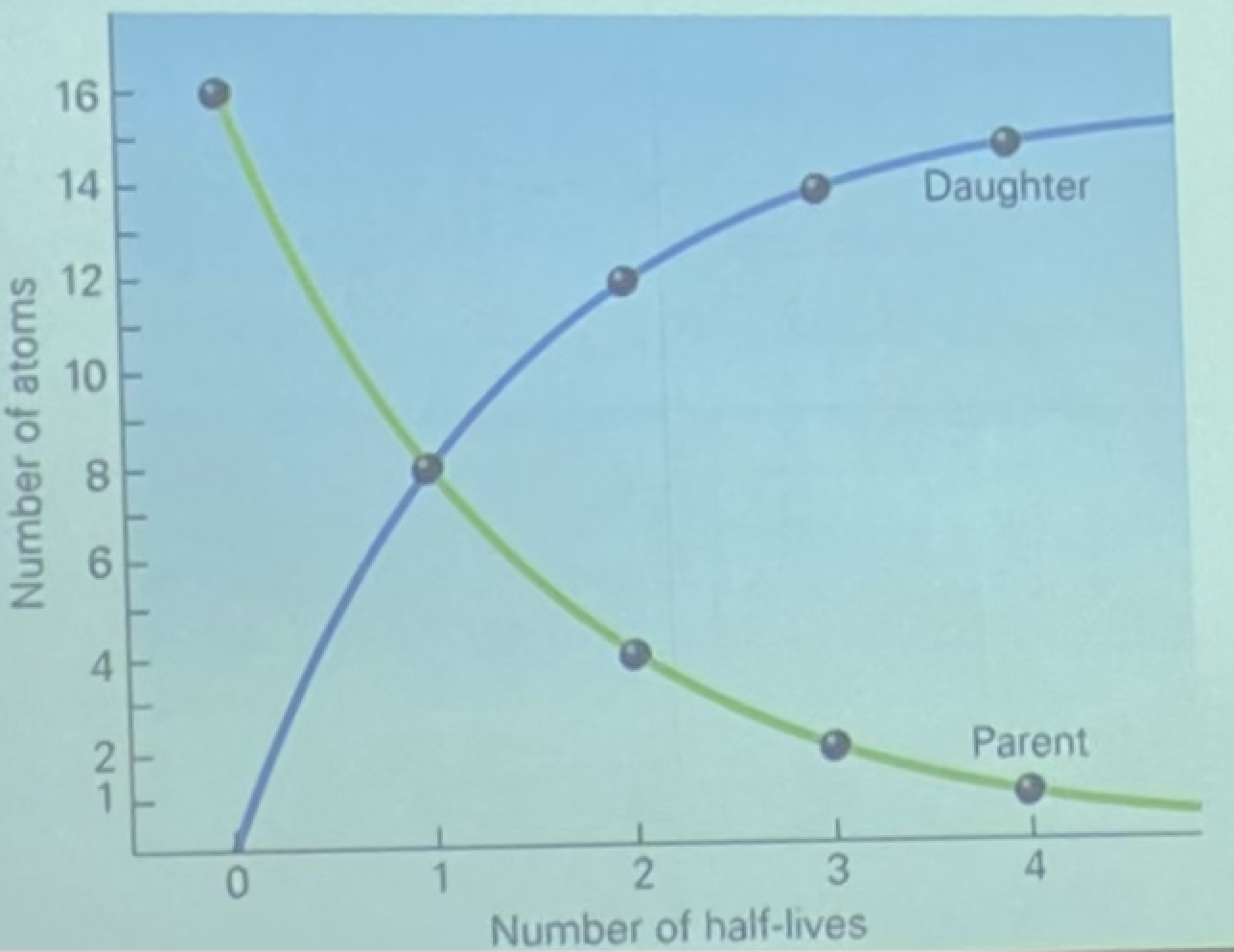
Absolute dating helps find the specific age of an object
Only used on igneous rock
Stratigraphic columns - what they represent, weathering profile (differential weathering) (60, 61)
Stratigraphic columns depict the strata present in a region.
Drawn to scale to represent thickness.
Shows different rock types.
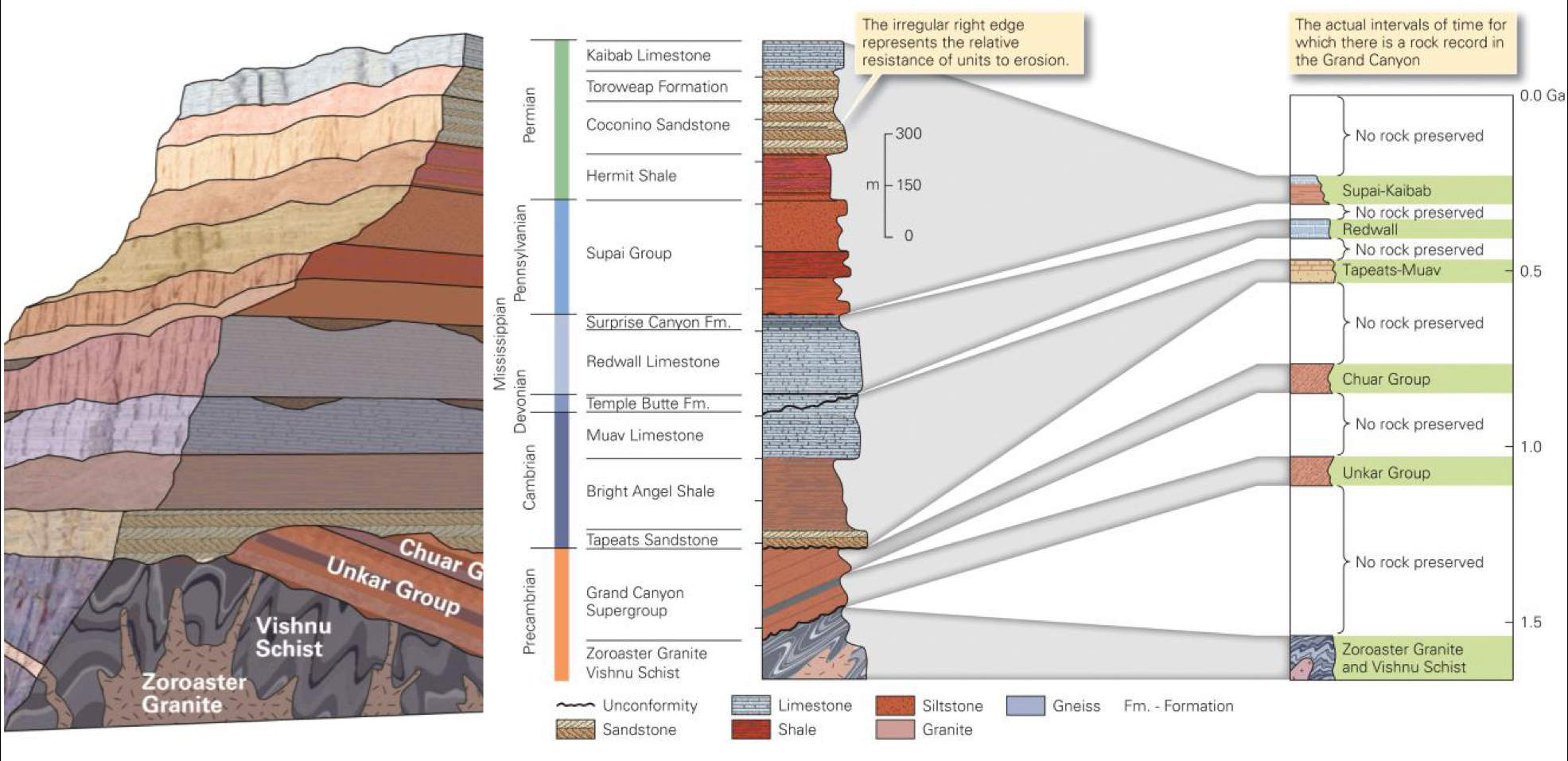
Class Questions
Cross-cutting intrusions best describe the notion that younger features truncate (cut across) older features.
Nonconformity is a gap in the geologic record between a metamorphic rock and a sedimentary rock.
Rivers: Interlude F and Chapter 14
Hydrological cycle and water distribution of freshwater (ground vs. lakes/streams) (1, 2)
Hydrosphere: all the water on Earth in all reservoirs.
The water cycle describes where water is on Earth and how it moves.
Continental divide (10)
Continental divide: separates flow to different oceans.
Watersheds
Tiny tributaries: tiny watersheds
Large continental rivers have large watersheds
Base level - local vs. ultimate (15 ,17)
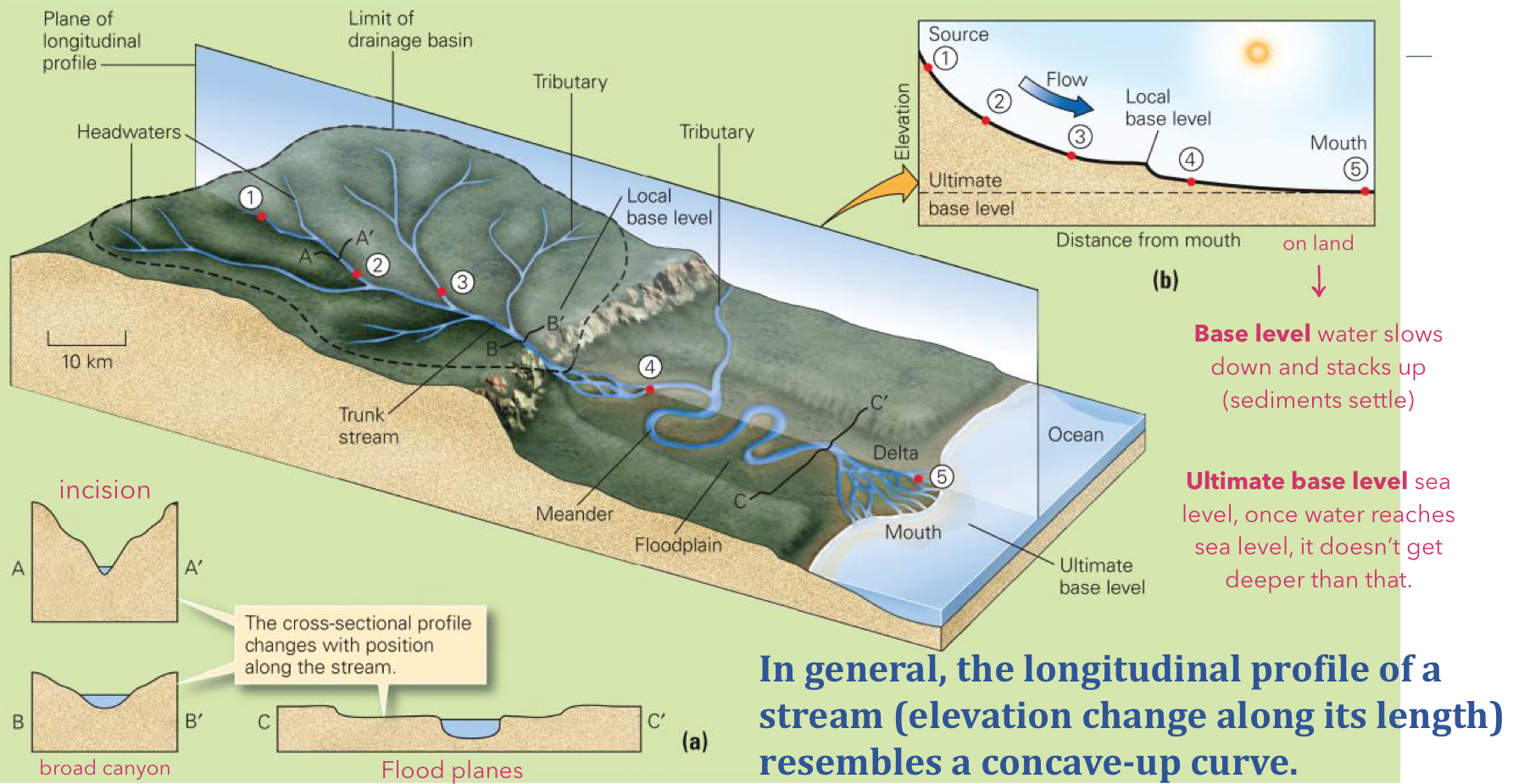
Base level → lowest point stream can erode.
Lake serves as local/temporary base level.
Ultimate base level is sea level.
Drainage networks (19)
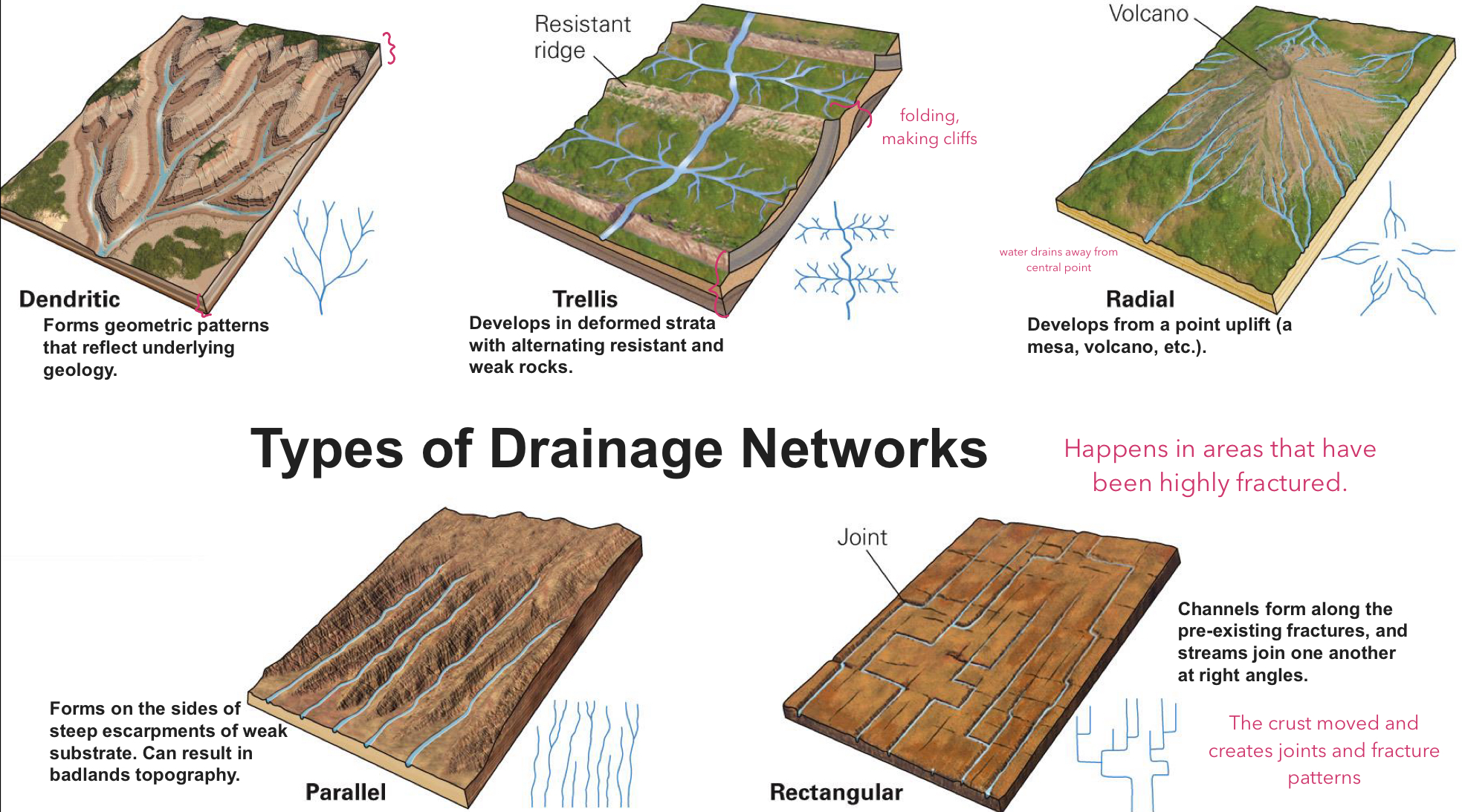
Water flow and stream capacity (dissolved load, suspended load, bedload) (23, 24)
The energy to move is gravity.
Water in a stream swirls and twists, producing turbulence.
Streams are constantly changing the land by erosion and deposition.
Forms of erosion: scouring, breaking, abrasion, and dissolution.
Material moved by streams is the sediment load (dissolved, suspended, bed loads)
Stream capacity: the total amount of sediment a stream can carry.
Dissolved load: ions dissolved in a stream’s water.
Suspended load: tiny solid grains carried along by a stream without settling to the floor of the channel.
Bedload: Large particles, such as sand, pebbles, or cobbles, that bounce or roll along a stream bed.
Types of streams - braided vs. meandering and features of meandering streams (28-30)
Braiding streams: form where channels are choked by sediment. Flow forced through sediment obstructions, the diverging and converging flow creates sand and gravels bars. Stream capacity is high.
Meandering streams: channels from intricately looping meanders along the lower gradient portion of the longitudinal profile.
Inside moves slowly.
In lower graded areas.
Evolve over time and cuts self of.
Cut banks vs. Point bars
Cut banks:
Outside curves
High stream velocity
Where erosion is greatest
Point bars:
Inside curves
Low stream velocity
Deposition of sediments is greater
Recurrence intervals (44, 45)
Annual probability is 1/recurrence interval
A 100 year flood has a 1/100 chance of happening in a given year.
Groundwater: Chapter 16
Groundwater basics (4)
Hydrogeology: the study of groundwater.
Groundwater is the 3rd largest reserve of water on the planet.
It fills pore spaces in rock buried below the surface
Requires porosity and permeability of the reservoir rock.
Porosity and permeability - what makes a good aquifer (5-7)
Groundwater resides in pore spaces between gaps of sediment rock.
Porosity: the total volume of open space
Can be filled with water, air, mineral cement, or other fluids.
2 categories
Primary porosity: open space within rock that originally formed with the material.
Includes voids in sediment, vesicles in basalt, and open cavities in reef limestone.
Decreases with burial compaction and cementation.
Crystalline rocks have very little primary porosity.
Secondary porosity: new pore space created after rock was first formed.
Examples: joints, faults, and solution cavities.
Permeability: the degree to which a material allows fluids to pass through it due to pore interconnectedness.
High permeability → water to flow readily
Low permeability → water flows slowly
Aquifer basics and types - confined vs. unconfined, aquitard (9)
Aquifer: rock that holds and transfer water.
Aquitard: lower permeability rock that hinders water flow.
Unconfined aquifer: lies at surface and is easily contaminated.
Confined aquifer: lies beneath an aquitard and is isolated from the surface, so it considered cleaner water.
Water table (10, 11)
Water table: the top of the groundwater reservoir in the subsurface. Separates the unsaturated zone from the saturated zone.
Capillary fringe forms at the boundary.
Depth of water table varies with the climate and seasons.
Examples:
Humid regions → water table close to surface
Dry regions → water table sinks deep below
Groundwater flows from recharge areas to discharge areas along flow paths.
Groundwater infiltrates at recharge areas, which are at higher elevations.
Groundwater exits subsurface at discharge areas, which occur at lower elevations.
Groundwater flow occurs on a variety of time and spatial scales
Deeper flows paths have longer transit times.
Potentiometric surface (13)
Potentiometric surface: an analog of the water table for a confined aquifer.
A hypothetical plane where a fluid reservoir will "equalize out to" if allowed to flow.
Groundwater issues - contamination, cone of depression, groundwater mining (19, 22)
Water table decline results in altered surface water flow.
Water in pore space acts to hold grains apart.
When groundwater is depleted, sediment grains compress and the pores collaspe.
Causes land surface to crack and subside.
Extreme examples of water contamination - Cuyahoga River (25, 28)
Human activities contaminate water.
Agriculture pollution is main source for surface water contamination.
Industrial and commercial discharge is the leading source for groundwater contamination.
Cuyahoga River
Streams were contaminated
Industrial centers, flushed contaminates down streams
Industry dumping
Waste products would get ignited and burn for awhile.
GEOL 101 Exam 2 Review
Sedimentary Rocks: Interlude B and Chapter 6
Introduction to sedimentary rocks (5, 6)
Sedimentary rock: Rock that forms by cementing together of fragments, broken off, pre-existing rock, or by the precipitation of mineral crystals out of water solutions at or near the earth surface.
Las Vegas is built on unconsolidated sediment.
Most of the Earth’s surface is covered with layers of loose sediment.
~75% of the land surface is sedimentary rock.
All sediment and sedimentary rock make up less than 10% of all rocks on this planet.
Sedimentary rocks preserve the history of how the surface environment changed through time.
Sedimentary rocks are the only rocks with fossils inside them.
Sedimentary rocks hold all of Earth’s reserves of:
Oil
Gas
Coal
Groundwater
Sand is the second most used resource behind water.
Sediments: loose fragments of rocks or minerals from the weathering process.
Transforms bedrock into detrital clasts and possibly into soil.
Clasts: Can be the broken down bits of a rock. Can be a mineral that wasn’t created but it was eroded out, broken out, or weathered out and now its loose clast.
Types of weathering
Physical weathering: Erodes rock into clasts of variable size.
Jointing: causes natural cracks in rock
Wedging: forces causing expansion of preexisting cracks in rock (root, salt, ice).
Chemical weathering: Chemical reactions of minerals in rocks to air or water.
Dissolution: causes minerals in rocks to dissolve in water (ex: calcite).
Oxidation: a reaction where elements combine with oxygen.
Differential weathering: Different layers of rock weather at different rates due to their difference in composition.
Sedimentary rock types (16)
Clastic: loose rock fragments (clasts) cemented together.
Chemical/biochemical: minerals that crystallize directly from water or from biologic activity.
Organic: carbon-rich remains of once-living organisms.
Clastic sedimentary rocks and grain characteristics (rounding, sorting, size) (17-19)
Clastic sedimentary rocks: consists of mineral grains, rock fragments, and cementing material.
Clastic sedimentary rocks are formed by:
Weathering: rock disintegration
Erosion: removal of grains
Transportation: movement of sediments by gravity, wind, water, and ice
Deposition: settling out of the transportation medium
Compaction: additional overlying material provides pressure
Lithification: transformation into solid rock
Grain size: the diameter of individual grains of sediment or lithified particles in clastic rocks.
Very coarse to very fine
gravel, sand, silt, and clay
As transport distance increases, grain size decreases.
Angularity: degree of edge or corner smoothness
Angular, subangular, subrounded, rounded
Angular edges → rock was formed close to where it was weathered.
Rounded → rock was formed farther away from spot of origin.
As transport distance increases, roundness increases.
Sorting: a measure of the uniformity of grain sizes in rock (poorly to well sorted)
As transport distance increases, sorting increases (well sorted)
Very poorly sorted, poorly sorted, moderately sorted, well sorted, very well sorted
Conglomerate rock → coarse, angular, gravel, poorly sorted
Sandstone → medium grain, subangular, sand, moderately sorted
Siltstone → medium/fine grain, subrounded, silt, well sorted
Shale → fine grained, rounded, clay and silt, very well sorted
Chemical sedimentary rocks (25,26)
Chemical sedimentary rocks: produced by inorganic precipitation of dissolved compounds (example: through oversaturation or evaporation).
Limestone
Evaporites
Biochemical sedimentary rocks: made of sediments from the shells of once-living organisms.
Depositional environments for rock outcrops found around Las Vegas (38-43)
Depositional environments: the environment where the rock was formed.
Different environments vary in energy regime, sediment transport, and depositional processes and chemical, physical, and biological characteristics.
Mt. Charleston
Limestone
Red Rock Canyon
Cross-bedding
Fossils
Tule Springs Fossil Beds
Fossils
Sedimentary structures - cross bedding (33, 34)
Bedding reflects changing conditions during deposition.
Stratification displays sedimentary rocks as layers, close to horizontal beds.
Bedding plane: the boundary between two beds.
Water flowing over loose sediments creates bedforms, which directly reflect flow velocity and grain size. They are useful indicators of environmental conditions.
Ripple marks: ridges and troughs that develop perpendicular to flow in sandy sediments.
Cross bedding: created by ripple and dune migration
Sand moves up the gentle side and piles up at the crest.
Then, it slips down the steep face.
The slip face faces are preserved as cross beds.
Graded bedding: from bottom to top, coarse materials settle and finer grains are seen on the top part of the bedding.
Mud cracks: indicate alternate wet and dry terrestrial conditions.

Metamorphic Rocks: Chapter 7 and Interlude C
Intro to metamorphic rocks, alteration of mineralogy and texture (5-7)
Metamorphic rocks: are those that have undergone solid-state diffusion of pre-existing rocks.
Meta means change, morphe means form
Protoliths: pre-existing rocks that are altered during metamorphism.
Metamorphism can alter any protolith (igneous, sedimentary, metamorphic).
Protoliths undergo changes in mineralogy and texture due to variations in temperature, pressure, tectonic stress, and water.
Mineralogy of metamorphic rocks
Metamorphic rocks may keep some of the same minerals of its protolith, but can form new minerals too.
Texture of metamorphic rocks
Metamorphism creates intergrown and interlocking grains.
Metamorphism often imparts a foliation upon the new rock.
Foliation is a planar fabric that cuts through the rock due to alignment of platy minerals and can lead to alternating light/dark bands.
Agents of metamorphism - Temperature and Pressure (8)
Temperature: heat causes the atoms in a mineral to vibrate, rapidly, stretching, bending, or breaking chemical bonds. Between 500-1500 F
Can cause ions to break a part.
Pressure: near the surface, minerals are more stable, under extreme pressure is the atoms can pack together, more closely in denser minerals form.
Temperature and pressure determine metamorphic grade.
Metamorphic grade - low to high grade metamorphism (9, 10)
Metamorphic grade is a measure of the intensity of temperature and pressure conditions that lead to alteration.
Different temperature and pressure conditions occur in different geologic settings.

Low temperature, low pressure → low grade
High temperature, high pressure → high grade
In between temperature and pressure → intermediate grade
A sedimentary protolith (shale) changes to into different rocks with increasing metamorphic grade (increasing heat and pressure).
Shale → Slate → Schist → Gneiss


Metamorphic settings - contact vs. regional vs. subduction (11, 12)
Contact/thermal (slides 13-15)
Low pressure, high temperature
Plutonic intrusion - heat from a body of magma invading host rock
Hydrothermal waters - cold water seeps into fractured crust, water is heated by magma, hydrothermal water reacts and chemically alters basalt.
Dynamic fault zone shearing - breaking of rock
Subduction (slide 16)
Volcanic arc (low pressure, high temperature)
Accretionary prism (high pressure, low temperature)
Regional (slide 17)
Pressure and temperature fluctuate
Mountain forming event
Burial
Orogenesis - development of mountain belts
Not all agents are required to alter a rock mass, although they often co-occur.
Metamorphic processes - recrystallization and neocrystallization (20, 21)
Recrystallization: changes the texture (size and shape of crystals), but the minerals stay the same. Caused by change in temperature.
Neocrystallization: results in new (metamorphic) minerals from old (those that were in the protolith).
Protolith minerals become unstable and undergo chemical reactions that recycle elements to form a new mineral assemblage.
Texture can change and foliation can occur.
Foliation from differential stress (24, 26)
Differential stress: stress that is greater in ONE direction.
Differs from pressure because pressure is of equal magnitude in all directions.
It causes inequant mineral shapes to align in preferred orientations.
Commonly takes place from tectonic forces.
Mountain building → horizontal compression (push)
Rifting → horizontal extension (pull)
Two types of differential stress: Normal and Shear
1.) Normal stress: operates perpendicular to a surface.
Compression: push-together normal stress
Tension: pull-apart normal stress
2.) Shear stress: acts parallel to a surface.
Compression and shear combined with elevated temperature and pressure cause minerals and rocks to change shape without breaking.
Internal textures are changed as minerals rotate or dissolve and recrystallize in preferred orientations.
Differential stress results in foliation of a rock.
Rock cycle case study - Black Hills (47)
Began with sedimentary rocks.
An igneous intrusion metamorphosed the sedimentary rocks through contact metamorphism to make schist.
Sedimentary rocks were buried, underwent uplift and erosion, brought igneous and metamorphic rocks to the surface.
Another sea covered the area creating think sedimentary rock sequence. Limestone had undergone dissolution to form a vast cave system in the hills.
Another intrusion occurs, uplifts entire rock sequence, begins the uplift of the Rocky Mountains.
Sedimentary rocks erode away from high relief areas and exposes crystalline core. Sedimentary rocks ring outer parts of the hills.
Sediment transferred eastward through streams, sediments traveled to flatter lying areas, created sediments seen in Badlands.
Class Questions
The main difference between pressure and differential stress is that differential stress applies pressure, but that pressure is unequal in all directions - meaning there is more pressure coming in from one of these sides.
Foliation is the term that best describes the changes that occur to a metamorphic rock when a planar fabric cuts through rock?
Fossils and Geologic Time: Interlude E and Chapter 10
Intro to fossils (2)
Paleontology: the study of fossils.
Fossils are remnants or traces of ancient living organisms.
Created by burial with rock material and preserved lithification.
Fossils are in sedimentary rocks, some in air-fall ash deposits.
Fossilization modes - types of preservation and how preservation takes place (4, 6, 8)
Mummification
Freezing
Aridity
Burial
Stages
Footprints left in mud
Dinosaur collapses and dies
Flesh rots, bones remain
Water level increases, sediments bury footprints and bones
Think sequence of sediments collects over bones, bones fossilize
Erosion exposes bed containing the bones and footprints
Amber
Molds/casts of invertebrates
Trace fossils of footprints, burrows, or dung
Recrystallization of body fossils
Permineralization of plants
Carbonization of soft organisms
Highest preservation potential with:
Rapid burial and low energy
Low oxygen (anoxic)
Hard parts
No diagenesis
No metamorphism
What gets fossilized:
Hard parts or traces - mostly
Exoskeletons, shells, teeth, bones, bark, tracks, impressions
Soft parts - but rarely
Internal organs, skin tissue, feathers
What fossils can tell us (11)
Individuals
Behavior
Morphology and mechanistics
Paleopathology
Community dynamics
Who’s top predator
Paleoecology
Paleoenvironments
Evolution (14)
Evolution: the gradual change of physical traits of organisms through time.
Taxonomic relationships - Kingdom down to genus → more closely shared traits (16)
Taxonomy: how we classify organisms
Binomial nomenclature: every organism has a two part scientific name that identifies its closest relatives and infers its evolutional history.
Eukarya is the most inclusive.
Humans are related to worms on animal kingdom level.
Middle column of table shows how subdivisions apply to humans.
As you move down, more traits are shared.

Mass extinctions - 6 mass extinctions have taken place (21)
Extinctions - when last member of a species die off.
Mass extinctions are global, abrupt decreases biodiversity.
6 mass extinctions:
Ordovian-Silurian
Late Devonian
Permian-Triassic
Triassic-Jurassic
Cretaceous-Paleogene
Anthropocene
Geologic time scale(25, 26)
Geologic time scale: Precambrian → Paleozoic → Mesozoic → Cenozoic → Anthropocene
Age of humans: Anthropocene

Relative dating principles #1-8 (30-37)
1 block digram will be on the exam
Uniformitarianism: processes observed today are the same as what has occurred through Earth’s history.
Original horizontality: sediments settle out of fluid by gravity and accumulate horizontally, tilted sedimentary rocks must be deformed.
Superposition: an undeformed sequence of layered rock has youngest strata on top, oldest on the bottom.
Lateral continuity: subsequent erosion dissects once-continuous layers.
Cross-cutting relations: younger features cut across older features.
Faults, dikes, erosion must be younger than the material faulted, intruded, or eroded.
Baked contacts: igneous intrusion cooks the invaded country rock.The baked rock is older.
Inclusions: occurrence of rock fragments within another rock. Inclusions are older than the enclosing material. Fragments (xenoliths) in igneous intrusion are always older. Rock had to exist first to be included in another rock.
Faunal succession: species evolve, exist for a time, and then disappear. Useful for relative dating.
Relative dating application (41)
Helps sort out sequence of events and relative ages of complex situations.
Diagram is on exam,must be able to put them in order.
1. Limestone
2. Shale
3. Sandstone
4. Shale
5. Sandstone
6. Shale
7. Sandstone
Darker gray layer → sill
Vertical gray → basalt dike

Unconformities - angular, non, dis, and rock types/relationships associated with each (46-48)
Unconformities: gaps in the rock record from either nondeposition or erosion.
Angular unconformity: underlying layers are tilted.
Nonconformity: underlying layers are igneous or metamorphic rocks, layers are not tilted.
Example: Black hills
Disconformity: underlying layers are sedimentary, layers are not tilted.
Example the Grand Canyon
Absolute dating - parent → daughter, half life, what rocks can be dated (54, 55, 57)
Parent isotopes to daughter isotopes, they decay by half-life, that half life is strict, unmoving. Its the same rate every single time it’s decay takes place.
Isotopes - elements with varying neutrons
Half life - time it takes for half of unstable nuclei to decay.
As parent disappears, daughter increases
1 half life → ½ of the original parent remains.
2 half lives → ¼ of the original parent remains.
3 half lives → 1/8 of of the original parent remains.

Absolute dating helps find the specific age of an object
Only used on igneous rock
Stratigraphic columns - what they represent, weathering profile (differential weathering) (60, 61)
Stratigraphic columns depict the strata present in a region.
Drawn to scale to represent thickness.
Shows different rock types.

Class Questions
Cross-cutting intrusions best describe the notion that younger features truncate (cut across) older features.
Nonconformity is a gap in the geologic record between a metamorphic rock and a sedimentary rock.
Rivers: Interlude F and Chapter 14
Hydrological cycle and water distribution of freshwater (ground vs. lakes/streams) (1, 2)
Hydrosphere: all the water on Earth in all reservoirs.
The water cycle describes where water is on Earth and how it moves.
Continental divide (10)
Continental divide: separates flow to different oceans.
Watersheds
Tiny tributaries: tiny watersheds
Large continental rivers have large watersheds
Base level - local vs. ultimate (15 ,17)

Base level → lowest point stream can erode.
Lake serves as local/temporary base level.
Ultimate base level is sea level.
Drainage networks (19)

Water flow and stream capacity (dissolved load, suspended load, bedload) (23, 24)
The energy to move is gravity.
Water in a stream swirls and twists, producing turbulence.
Streams are constantly changing the land by erosion and deposition.
Forms of erosion: scouring, breaking, abrasion, and dissolution.
Material moved by streams is the sediment load (dissolved, suspended, bed loads)
Stream capacity: the total amount of sediment a stream can carry.
Dissolved load: ions dissolved in a stream’s water.
Suspended load: tiny solid grains carried along by a stream without settling to the floor of the channel.
Bedload: Large particles, such as sand, pebbles, or cobbles, that bounce or roll along a stream bed.
Types of streams - braided vs. meandering and features of meandering streams (28-30)
Braiding streams: form where channels are choked by sediment. Flow forced through sediment obstructions, the diverging and converging flow creates sand and gravels bars. Stream capacity is high.
Meandering streams: channels from intricately looping meanders along the lower gradient portion of the longitudinal profile.
Inside moves slowly.
In lower graded areas.
Evolve over time and cuts self of.
Cut banks vs. Point bars
Cut banks:
Outside curves
High stream velocity
Where erosion is greatest
Point bars:
Inside curves
Low stream velocity
Deposition of sediments is greater
Recurrence intervals (44, 45)
Annual probability is 1/recurrence interval
A 100 year flood has a 1/100 chance of happening in a given year.
Groundwater: Chapter 16
Groundwater basics (4)
Hydrogeology: the study of groundwater.
Groundwater is the 3rd largest reserve of water on the planet.
It fills pore spaces in rock buried below the surface
Requires porosity and permeability of the reservoir rock.
Porosity and permeability - what makes a good aquifer (5-7)
Groundwater resides in pore spaces between gaps of sediment rock.
Porosity: the total volume of open space
Can be filled with water, air, mineral cement, or other fluids.
2 categories
Primary porosity: open space within rock that originally formed with the material.
Includes voids in sediment, vesicles in basalt, and open cavities in reef limestone.
Decreases with burial compaction and cementation.
Crystalline rocks have very little primary porosity.
Secondary porosity: new pore space created after rock was first formed.
Examples: joints, faults, and solution cavities.
Permeability: the degree to which a material allows fluids to pass through it due to pore interconnectedness.
High permeability → water to flow readily
Low permeability → water flows slowly
Aquifer basics and types - confined vs. unconfined, aquitard (9)
Aquifer: rock that holds and transfer water.
Aquitard: lower permeability rock that hinders water flow.
Unconfined aquifer: lies at surface and is easily contaminated.
Confined aquifer: lies beneath an aquitard and is isolated from the surface, so it considered cleaner water.
Water table (10, 11)
Water table: the top of the groundwater reservoir in the subsurface. Separates the unsaturated zone from the saturated zone.
Capillary fringe forms at the boundary.
Depth of water table varies with the climate and seasons.
Examples:
Humid regions → water table close to surface
Dry regions → water table sinks deep below
Groundwater flows from recharge areas to discharge areas along flow paths.
Groundwater infiltrates at recharge areas, which are at higher elevations.
Groundwater exits subsurface at discharge areas, which occur at lower elevations.
Groundwater flow occurs on a variety of time and spatial scales
Deeper flows paths have longer transit times.
Potentiometric surface (13)
Potentiometric surface: an analog of the water table for a confined aquifer.
A hypothetical plane where a fluid reservoir will "equalize out to" if allowed to flow.
Groundwater issues - contamination, cone of depression, groundwater mining (19, 22)
Water table decline results in altered surface water flow.
Water in pore space acts to hold grains apart.
When groundwater is depleted, sediment grains compress and the pores collaspe.
Causes land surface to crack and subside.
Extreme examples of water contamination - Cuyahoga River (25, 28)
Human activities contaminate water.
Agriculture pollution is main source for surface water contamination.
Industrial and commercial discharge is the leading source for groundwater contamination.
Cuyahoga River
Streams were contaminated
Industrial centers, flushed contaminates down streams
Industry dumping
Waste products would get ignited and burn for awhile.
 Knowt
Knowt